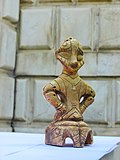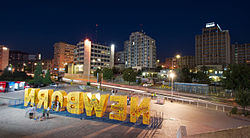Pristina
Pristina[3] or Prishtina (UK: /ˈpriːʃtɪnə, prɪʃˈtiːnə/,[4] US: /ˈprɪʃtɪnə, -nɑː/;[5] Albanian: [Prishtina] Error: {{Lang}}: text has italic markup (help) or Prishtinë [pɾiʃˈtinə] (![]() listen); Serbian: Приштина) is the capital city of Kosovo. It has a mostly Albanian population, but also some Serbs.[6][7] It is in the north-eastern part of Kosovo, close to the Goljak mountains.
listen); Serbian: Приштина) is the capital city of Kosovo. It has a mostly Albanian population, but also some Serbs.[6][7] It is in the north-eastern part of Kosovo, close to the Goljak mountains.
Municipality and city | |
| Coordinates: 42°39′48″N 21°9′44″E / 42.66333°N 21.16222°E | |
| Country | Kosovo |
| District | Pristina |
| Municipality | Pristina |
| Government | |
| • Type | Mayor–council |
| • Mayor | Përparim Rama (LDK) |
| • Council | Pristina Municipal Council |
| Area | |
| • Municipality[1] | 523.13 km2 (201.98 sq mi) |
| Population (2011) | |
| • Urban | 161,751 |
| • Rural | 37,146 |
| • Municipality[2] | 198,897 |
| Time zone | UTC+1 (CET) |
| • Summer (DST) | UTC+2 (CEST) |
| Postal code | 10000 |
| Motorways | |
| Major airport | Adem Jashari Airport |
| Vehicle registration | 01 |
| Website | kk.rks-gov.net/prishtine/ |
History
In ancient history, the Vinča culture lived in the area.[8][9][10] The city was part of the Roman Empire between 28 BC and 850 AD. After that, the Byzantine and Bulgarian Empires fought for control, taking Kosovo back and forth, between 850 and 1180. Then it became part of the Kingdom of Serbia. For most of that time, it was the capital of Serbia. When the Serbs lost the Battle of Kosovo, the Ottoman Empire took the city. They brought Islam to Kosovo. While Kosovo was part of the Ottoman Empire, most Albanians became Muslims. Some Slavs did too.[11] In the 1680s, the Austrian Empire conquered Kosovo for a short time, but it was retaken by the Ottomans.[12]
In 1912, Albanian rebels led by Hasan Pristina took the city.[13] A few months later, the Kingdom of Serbia captured Pristina. Then, in the Second Balkan War, the Bulgarian Empire took Pristina from Serbia.[14] Then, in December 1918, French colonial troops took Pristina, and gave it to the Kingdom of Serbia, which was now known as the Kingdom of Serbs, Croats, and Slovenes.[14] In the next years, Serbs would take Turkish land and property by force. Most Turks left, and some Albanians did too.[15]
On 17 April 1941, Yugoslavia surrendered to the Axis Powers. On 29 June, Benito Mussolini said that there would be a Greater Albania, and that Kosovo would be a part of it. After that, Italian and Albanian fascists killed lots of Serbs, and tens of thousands left Kosovo.[16][17] After Italy switched sides to the Allied Powers, Nazi Germany took control of Pristina. 281 local Jews were arrested by an Albanian Schutzstaffel (SS) division. They were sent to Germany, where many were killed.[18][19] Due to the chaos caused by World War II, as well as many people being forced to leave, Pristina's population dropped to 9,631 people.[15]
After World War II, Yugoslavia became a communist country. Large parts of the town were destroyed to try to make room for new buildings, including most of the town center. This included a lot of buildings that had been built by the Ottomans. Pristina got a lot of money from the Yugoslav government because it was the capital of the Autonomous Province of Kosovo and Metohija, so it developed quickly. The University of Pristina was founded, lots of high-rise apartment blocks were built, and a new industrial zone near the city attracted a lot of people from other parts of Kosovo. Pristina's population increased very quickly, from 69,514 in 1971 to 109,208 in 1981. But this period of quick growth was soon ended by an economic and social crisis. After Tito died, the many different ethnic groups in Yugoslavia started having troubles with each other. This included the Serbs and Albanians.[20][21]
Pristina Media
The Monument of Brotherhood and Unity by Miodrag Živković in the city center. "Brotherhood and unity" was a popular slogan of the Communist Party of Yugoslavia.
Destruction of Bazaar of Pristina after World War II
References
- ↑ "Komisioni për majten e territorit të Republikës së Kosovës" (PDF) (in shqip). Prime Minister Office of Kosovo. p. 52. Archived from the original (PDF) on 22 September 2020. Retrieved 2 October 2021.
- ↑ "Regjistrimi i Popullsisë, Ekonomive Familjare dhe Banesave në Kosovë 2011 – Rezultatet Përfundimtare: Të Dhënat Demografike sipas Komunave" (PDF) (in shqip). Kosovo Agency of Statistics. p. 14. Archived from the original (PDF) on 4 March 2016. Retrieved 4 October 2021.
- ↑ "Define Pristina". Dictionary.com. Retrieved 28 October 2013.
- ↑ "Pristina". Collins English Dictionary. HarperCollins. Retrieved 15 May 2019.
- ↑ "Priština"[dead link] (US) and "Priština". Oxford Dictionaries. Oxford University Press. Retrieved 15 May 2019.
{{cite web}}: no-break space character in|work=at position 9 (help) - ↑ Prishtina Development Plan Document: http://prishtinaonline.com/uploads/prishtina_pzhk_2012-2022_shqip%20(1).pdf
- ↑ Official gov't census: http://esk.rks-gov.net/rekos2011/repository/docs/REKOS%20LEAFLET%20ALB%20FINAL.pdf Archived 2013-11-10 at the Wayback Machine
- ↑ [1], The Cambridge ancient history: The fourth century B.C. Volume 6 of The Cambridge ancient history, Iorwerth Eiddon Stephen Edwards, ISBN 0-521-85073-8, ISBN 978-0-521-85073-5, Authors: D. M. Lewis, John Boardman, Editors: D. M. Lewis, John Boardman, Edition 2, Publisher: Cambridge University Press, 1994 ISBN 0-521-23348-8, ISBN 978-0-521-23348-4.
- ↑ Adams, Douglas Q. (1997). James P. Mallory (ed.). Encyclopedia of Indo-European Culture. Fitzroy Dearborn. ISBN 978-1-884964-98-5.
- ↑ Wilson, Nigel Guy (2006). Encyclopedia Of Ancient Greece. Taylor & Francis Group. ISBN 978-0-415-97334-2.
- ↑ Noel Malcolm, A Short History of Kosovo, pp.104–138
- ↑ Noel Malcolm, A Short History of Kosovo, p. 161
- ↑ Bogdanović, Dimitrije (November 2000) [1984]. "Albanski pokreti 1908–1912.". In Antonije Isaković (ed.). Knjiga o Kosovu (in Serbian). Vol. 2. Belgrade: Serbian Academy of Sciences and Arts. Archived from the original on January 31, 2011. Retrieved January 9, 2011.
... ustanici su uspeli da ... ovladaju celim kosovskim vilajetom do polovine avgusta 1912, što znači da su tada imali u svojim rukama Prištinu, Novi Pazar, Sjenicu pa čak i Skoplje ... U srednjoj i južnoj Albaniji ustanici su držali Permet, Leskoviku, Konicu, Elbasan, a u Makedoniji Debar ...
{{cite book}}: CS1 maint: unrecognized language (link) - ↑ 14.0 14.1 Elsie, Robert (2010). Historical Dictionary of Kosovo. Scarecrow Press, Inc. pp. xxxiv. ISBN 978-0-8108-7231-8. Retrieved 2013-05-18.
- ↑ 15.0 15.1 Warrander, Gail (2007). Kosovo: The Bradt Travel Guide. The Globe Pequot Press Inc. pp. 85–88. ISBN 978-1-84162-199-9. Retrieved 2013-05-18.
- ↑ Murray 1999, p. 15.
- ↑ Sabrina P. Ramet The three Yugoslavias: state-building and legitimation, 1918–2005
- ↑ Fischer, Bernd Jürgen (1999). Albania at War, 1939–1945. West Lafayette, Indiana: Purdue Research Foundation. p. 187. ISBN 978-1-55753-141-4.
- ↑ Mojzes, Paul (2011). Balkan Genocides: Holocaust and Ethnic Cleansing in the 20th Century. Lanham, Maryland: Rowman & Littlefield. pp. 94–95. ISBN 978-1-4422-0665-6.
- ↑ Reuters 1986-05-27, "Kosovo Province Revives Yugoslavia's Ethnic Nightmare"
- ↑ Christian Science Monitor 1986-07-28, "Tensions among ethnic groups in Yugoslavia begin to boil over"
| Wikimedia Commons has media related to Lua error in Module:Commons_link at line 62: attempt to index field 'wikibase' (a nil value).. |
















